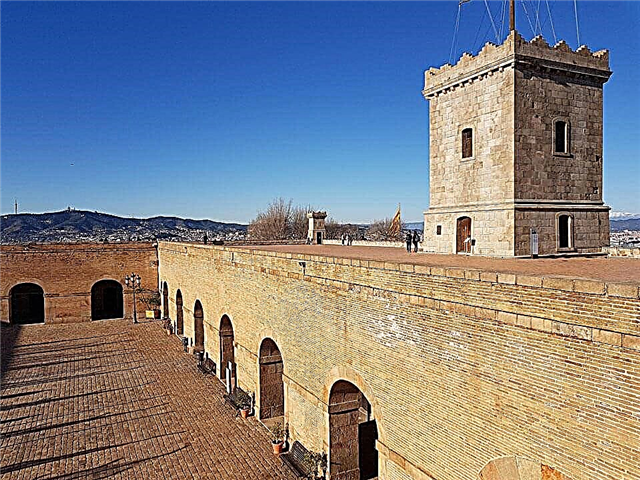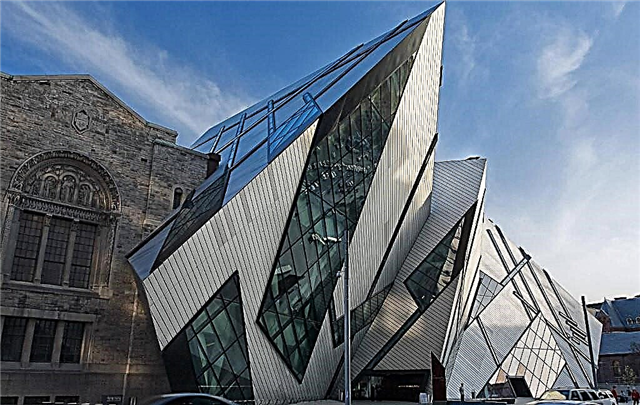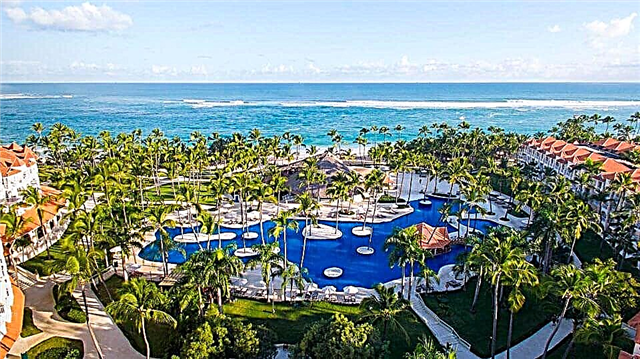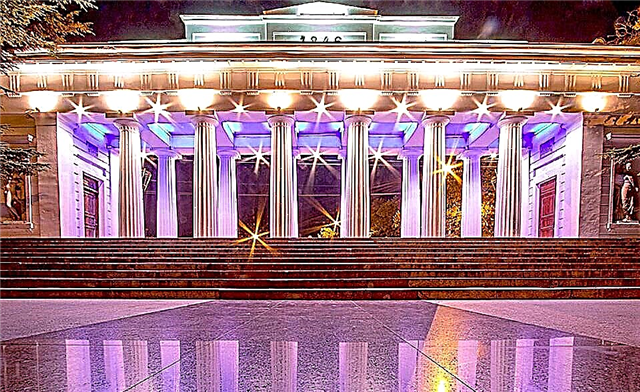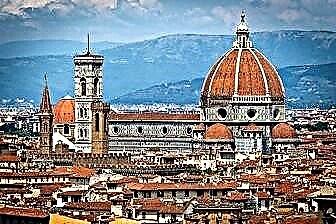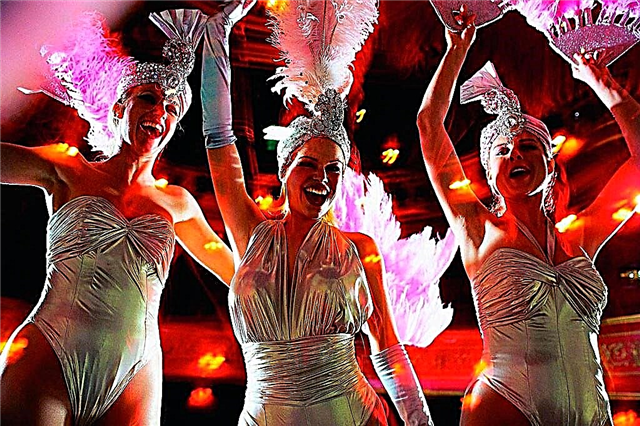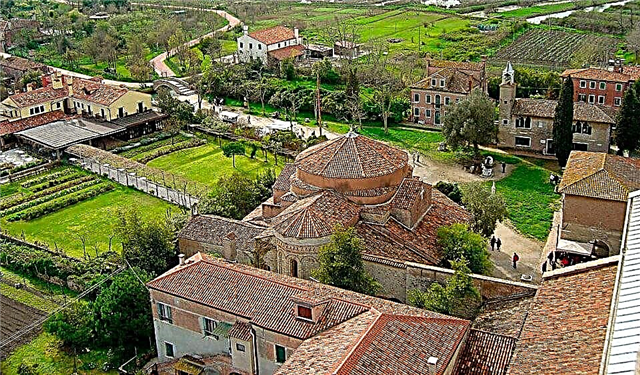A trip to Venice (another name for the city is "Serenissima" or the Most Serene, Clearest) can be compared to a fairy tale. The most beautiful, romantic city in the world with beautiful palaces, ancient temples, numerous museums, blooming parks, gardens gives rise to a difficult task of what to see in Venice in 4 days. How not to get lost in the beautiful realm of Gothic, luxurious Baroque, reflected in the waters of quaint canals? The article offers one of the options for getting to know the city in a short time.
First day in Venice
Usually this is the noisiest, most hopeful day of travel, when you want to see everything at once. When, numb from the delight of the first impressions of the “city on the water”, he is still full of strength, he is ready for any hikes.
St. Mark's Square

It is impossible not to notice this place. Every tourist who comes to Venice must appear on it. Only this (central square) the Italians call pyatse. Others are called campo, campiello (field of various sizes). The square acquired its modern size, trapezoidal shape in 1777. It is located next to the ancient Cathedral of St. Mark. The bell tower rises above it, dominating over the neighboring buildings, there are majestic sights: the Doge's Palace, the Basilica of St. Mark.
Old Proscurations (together with a clock tower), New Proscurations, library. Along the perimeter of the square, there is not a single simple building, without an ancient, interesting history. Their walls remember the sounds of the cheerful Venetian carnival that takes place on the square at all times. It is also famous for flocks of pigeons, amazing wooden walkways in case of floods. Films were often filmed in the square. There are many interesting legends about her that can be heard during excursions.
Giudecque Island

The wide canal of the Giudecca case (formerly called Vigano) separates Venice from the romantic, cozy island. From afar, houses with red roofs, three majestic marble churches, luxurious modern villas of local rich people attract attention. There is silence (there are no bridges on the island), romantic tranquility, beautiful nature. The main attraction of the island is the Church of Il Redentore (Christ the Savior). The temple was erected in 1592 as a sign of deliverance from the terrible plague in Italy (by the way, it did not reach the island).
The temple is considered an ideal example of the architectural creation of the famous master Palladio. Ideal proportions, a wide staircase, an original dome create an atmosphere of ancient buildings of antiquity. Inside the church there are rare frescoes, paintings by masters from Renaissance Venice. Among them are works by Francesco Bassano, Paolo Veronese, Tintoretto. By the way, it is forbidden for tourists to use a flash in the church (it has a negative effect on old paints).
Embankment of the Incurable

Parallel to the island of Giudecca, the Zattere embankment runs along the canal. In the distant past, this place was the mysterious embankment of the Incurable. It is not found on modern maps of Venice. The current Cathedral of Santa Maria della Salute, erected in memory of the victory over the plague, is considered to be an indirect confirmation of its location. It is located on the Dorsoduro spit and separates the Incurabili quarters (there was a hospital for terminally ill people here) and the Academy. And also signs with the inscription "Zattere, the former Incurables", hanging on the houses.
In Russia, the mysterious embankment is known from the famous essay by Joseph Brodsky. He loved Venice and came here often. Dedicated to her beautiful poems, essays. After his death, the poet's ashes were transferred from New York to the island of San Michele. In 2009, a memorial plaque was installed for him here (there is information that since 2010 the embankment has been returned to its former name, but there is no confirmation of this fact on the maps).
Campo Santa Margherita

A small square in the Dorsoduro region was formed together with the city in one century. The whole life of specific islands is connected with the kampo, where there were markets, children played, and artisans worked in their shops. In the center there was a well for collecting rainwater needed by the inhabitants. With the advent of aqueducts, it was no longer necessary, and the functions of many of the kampos changed. The largest ones still hosted religious events, performances, bullfights, processions, and public performances.
Plaza Santa Iaogerita is one of them. There are restaurants, cafes, shops and a market here. Nearby are the Ca Foscari University, several colleges, the railway station, which have made the square a favorite meeting place for young people. The architecture of the old church complements the atmosphere of real Venetian life.
Cathedral of Ca 'Rezzonico

You can admire the magnificent palace while walking along the Grand Canal. The palace was bought by the Rezioniko family and was called the Golden House. Its external beauty is complemented by rare collections of paintings, furniture, the best works of art of the 18th century, when, despite the decline of the reign of the Venetian Republic, the world plunged into the magic of theaters, luxury, and the splendor of amazing art. I learned the names of great masters who became great personalities in the history of the planet. Detailed information about the life of Venice during this period can be found by visiting the museum located in the palace.
Its inspection will begin with a hike up the amazing (ceremonial) staircase of the palace with a collection of paintings by Veronese Tintoretto, Mestrovich. In eleven rooms on the ground floor, there are priceless exhibits from the 18th century (sculptures, paintings, frescoes, furniture). Up to the fourth floor, exhibitions with new discounts constantly appear in the halls. Museum address: Dorsoduro, 3136, fondamenta Rezzonico. From spring to autumn, the museum is open from 10 am to 6 pm. The cost of entrance tickets must be specified during a specific trip.
Cathedral of Santa Maria della Salute

The building is one of the symbols of Venice, facing the old Doge's Palace. The majestic baroque cathedral was erected in 1681. Like many buildings in Venice, its appearance is associated with the end of the plague disaster in Italy, which claimed the lives of 100 thousand citizens of the country. Two snow-white domes (one large, another smaller cathedral), two small, beautiful bell towers rise above the building. Mass is celebrated here annually as a sign of the end of a fatal illness.
On this day, a pontoon bridge is erected between the basilica and the Doge's Palace. The massive facades of the church show rich pilasters, bas-reliefs, and columns. They are securely anchored to 100,000 wooden piles. Above the altar, created by Longen, there is an icon of the Mother of God, brought from Crete and made in the Byzantine style. Inside the church, there are several unique pieces of art by renowned artists. Cathedral address: Dorsoduro, campo della Salute 1b. The church is open from 10 am to 5.30 pm.
Church of Santo Stefano

The building is an example of a building made in the Gothic style. Above the entrance there is a bas-relief of St. Stephen standing in front of the angel (by Bartolomeo Bon). The cathedral was built in the 18th century for the monks of the Order of St. Augustine. The end of construction was carried out in 1325. Inside the church there is a large number of paintings, statues (in the form of figures of famous masters). The ceiling is made from the keel of the ship. It rests on columns made of beautiful types of white and red marble. The church has one central, two side naves, three apses.
The walls are painted with patterns in the form of acanthus leaves and decorated with diamonds. The painting "The Beating of Babies" makes a strong impression. During the initial period of 250 years, the church was consecrated six times. The church is located at Venice, Chiesa di Santo Stefano. Entrance without payment from 10 to 18 hours.The paintings by Tintoretto, kept in the sacristy, are allowed to be viewed with an admission fee of about 3 €.
Cathedral of Santa Maria Gloriosa dei Frari

Locals call the cathedral dedicated to the Assumption of the Virgin Mary, in one word Frari. the most famous cathedral is located in the square of the same name in the San Marco quarter. The building looks like a Latin cross, erected in accordance with the requirements of the Italian Gothic. There are pilasters and capitals on the brick facade of the church. They are made in the Byzantine style. The decoration of the main portal is the snow-white statues of the Resurrection of Christ, the Virgin Mary, Francis of Assisi.
Inside the church there are sculptures of famous saints, monuments to famous inhabitants of Venice, luxurious altars, bright frescoes, original stucco moldings made by Italian craftsmen. Among them there is a monument to the Doge of Pesaro, made of beautiful multi-colored marble (baroque style), famous paintings by Titian, an old XIII century cross with the image of Christ. Here is kept a crystal vase with the blood of Christ, which is the greatest of all relics. There is a bell tower near the cathedral. There is an observation deck on it that opens up an extraordinary panorama of the city.
Dinner at Cafe Florian

It is pleasant to sit in it, summing up the beginning of the journey. To plunge into the atmosphere created by the past eras (the cafe was opened in 1720), the interior of the halls, which are distinguished by the lush decor of different styles, the extraordinary smell, the taste of coffee and the view of the main square of Venice. In the oldest cafe in Europe, coffee is prepared according to 33 recipes that have made it a Mecca for drink fans. Important matters are still discussed over a cup of coffee, exhibitions are held (the first international art exhibition was held here in 1895).
Many famous personalities (Hemingway, Brodsky, Byron, Goethe, Casanova) were frequent visitors to the cafe with the original name "Venice of the Triumphal", "Arab", and then by the name of the owner Florian. Prices in a cafe are high, but visiting it, finding yourself in the heart of Venice, the center of the old social life of the city, is similar to visiting another attraction. It was not for nothing that Byron wrote that Florian was simultaneously a reading room, a stock exchange, a theater cafe, a confessional, a place for business meetings of businessmen and lawyers.
Second day in Venice
Before traveling to Venice, it is useful to make a preliminary plan for exploring its sights. Among them there may be famous places and small, especially interesting houses, parks, sculptures hidden among city streets. The second day of the trip reveals some of them.
Libreria Acqua Alta Bookstore

The second-hand bookstore (owned by Fritzo Luigi) is considered the most unusual bookstore in the world. Here water and books exist in an amazing way during the seasonal rise of water in the city, taking in the first floors of buildings. But books are not afraid of this rise. They are not stored on well-kept shelves, but in barrels, tubs, gondolas, and other gadgets. Important, serious cats keep a close eye on the order in the store. The original staircase, created from the volumes of the encyclopedia, leads to the exit of the store on the bank of the canal. There is no usual vaparetto stop nearby.
You can get to the store by water taxi or walk along interesting streets, bridges through the canals. It is difficult to find a more distinctive place that attracts the attention of visitors. Examining the halls of the store with tall stacks of books (sometimes they create real labyrinths), you find yourself in the atmosphere of antiquity, the smell of damp paper. Among the book chaos (at first glance) you can find books from different countries of the planet, magazines, posters, postcards, souvenirs, reproductions. Store address: Sestiere Castello, 5176 / B 30122. The store is open daily from 9 am to 8 pm.
Church of San Giacomo di Rialto

The cathedral is considered the oldest in Venice, built in 421 in the year the city was founded. Locals often refer to the architectural landmark as the Church of San Giacometo. The external appearance of the church has been preserved in its original form. The history of the building is connected with the development of the old Rialto market, located in a small square in front of the church. Inside it were numerous private merchants' altars dedicated to specific saints. Next to them, they prayed, asked for help, good luck in business. Historians say that the first trade deals in Venice took place within the walls of this church.
The first bank of the state was opened here in the 15th century. On the central part of the facade of the church (a small bell tower) there is still an antique clock from the 15th century with a unique dial. Inside the church there are statues of Jacob, Antonio the Great, created by the great masters Alessandro Vitorria and Giropamo Campagna. On the square there is a 16th century granite statue "The Hunchback", a small fountain. The address of the temple: San Giacomo di Rialto, Campo San Giacomo, 1. You can visit the church from 9 to 18 hours daily, without payment.
Basilica of San Marco

The beautiful, famous Church of Peace is located in St. Mark's Square in ancient Venice. The five-domed temple was erected in 828 in the role of the court chapel of the Doge's Palace. It housed the relics of the Apostle Mark. They were brought from Alexandria in January 829. The basilica has been rebuilt several times, acquiring by now numerous elements of different architectural styles. The temple was consecrated in 1094. The famous cathedral played an important role in the history of the republic: public performances by the doges and official ceremonies took place there. In the 19th century, the San Marco Museum was organized on the squares of the upper floors of the cathedral, introducing the history of the old cathedral of Venice.
Separate expositions present the history of the creation of a mosaic pattern that adorns the cathedral, a collection of icons, precious stones, unique woolen tapestries, and ancient chorales. The famous Creation dome, the Golden Altar or Pala d'Oro, unique bronze figures of four horses, Gothic arrows created from woven statues and numerous ancient relics captured during military campaigns. The current temple is located at St. Mark's Square. The ticket price for visiting the cathedral (according to a special timetable) is 3 €.
Doge's Palace

The main element of the famous architectural ensemble of Venice is the Doge's Palace (now it houses a museum). The monument of the late Gothic style was created during the heyday of the Venetian Republic according to the project of Calendario around 1424. From the side of the lagoon, the palace resembles an overturned ship. Several gates lead to the inner courtyard of the palace, including the famous Paper Gates, on which the orders of the rulers were hung. This is a three-storey building resembling the letter "P", made of marble of different colors. The first floor consists of a gallery of pointed arches. The second is built on the basis of tall, thick columns with boxes decorated with floral designs.
On the third floor, in a snow-white marble wall, there are numerous windows of different sizes. An important element of the palace is the festive balcony with the Justice Monument located on the southern façade. From here the decrees, sentences, considered in the conference room, were read out. Inside the building functioned the Supreme Court, the secret police, the censorship, the naval department, and special niches (lion's mouths) for denunciations were built in. The imposing Carrara marble staircase of the Giants was often used for ceremonies in Venice (the most important, called the wedding of the doge). Palace address: San Marco 1, entrance from the lagoon. The ticket costs 20 €. You can see the attraction from 8.30 to 19 daily.
Correr Museum

The famous art museum owes its existence to the passionate collector, Count (Abbot) Teodoro Correr. Personal collections of antiques and paintings became the basis for future rich expositions. They were in the building of an ancient palace located in San Zan Degolo.In the premises of the museum (a complex historical ensemble created in 1830), rare historical, divine works of Venice are kept. The expositions occupy 33 halls on the territory of the two floors of the New Prosecutor's Office.
Among them are the well-known symbols of the Venetian Republic, seals, personal belongings of the Doges, old nautical maps, old devices for navigating ships, portraits, etc. An art gallery occupies 19 rooms on the third floor. It contains canvases from the early painting of the masters of the Flemish school of painting to the present day. Among them is the famous work of Vittore Carpaccio "Courtesans". The archaeological department of the museum displays Egyptian and Roman artifacts. Museum address: Venezia, San Marco, 52. Entrance is organized from the main square of the city through the premises of Napoleon. The museum is open from 10 am to 7 pm. The ticket price is 16 €. There are preferential options.
Clock Tower of Saint Mark

The monument of the early Renaissance period (end of the 15th century) is easily recognizable by its elements (symbols of Venice) in the form of a Winged Lion with a book and the Mother of God with the Child Christ. At the top of the tower are two male bronze figures that sound the bell as the clock hand approaches a certain position. Sounds that appear on impact are distributed throughout the lagoon, indicating the current time. In 1493, not every city could afford to equip such a clock.
They have a navy blue dial with a globe in the center. The clock shows the change of seasons, the path of the Sun, the Moon through the signs of the Zodiac. The hour disc (with two facades) is decorated with gold-plated zodiacal figures. Bright stars are set against an attractive blue background. More than five centuries ago, they were created by a father and son from the Ranieri clan. The clock tower is located on the main square of the city, open to visitors (on pre-ordered excursion tours) from 9 to 16 hours.
Venetian arsenal

The "Workshop" or Arsenal of Venice is considered the first shipyard to provide ships to the whole world. In the Middle Ages, the Venetian Republic was considered the strongest maritime power. Its power comes from the mighty capabilities of Arsenal. The famous three-masted galley "Galeas" for the transport of heavy military equipment was created at this shipyard. The ship had a great influence on the subsequent stages of the development of naval technology. The construction of the landmark began in 1104.
Now it houses the Venice Maritime Museum (it occupies the premises of the Arsenal granary). The first floor is occupied by exhibits reflecting the level of artillery of the powerful Venetian Republic. The second floor is occupied by replicas of the famous ships of Venice. Among them is a copy of the ship "Buchintoro", which was used for ceremonial events by the Doges. The museum houses the famous bronze bell, which heralded the beginning of work for many centuries. The Arsenal's address is Venice, Castello, 30122. It is now closed to the public.
Church of San Pietro di Castello

The city of Venice is located on 118 islands. Among the first inhabited islands is a small piece of land in the form of the island of San Pietro (Olivolo). Together with the dwelling of people, a church appeared, which for a long time served as a cathedral (during the period from 1451 to 1807). Since 775, the Church of San Pietro di Castello was considered an episcopal see, served as the religious, administrative center of the city. The magnificent Basilica of San Marco, during this period of time, was the chapel of the Doge's palace.
The church has a monumental facade, a huge dome (its diameter is 54 m), the main altar of the Baroque style, and a bas-relief depicting the Adoration of the Magi. The main treasures of the church are paintings by Veronese, Tintoretto, the famous frescoes by Jacolo Palma. On the territory of the church there is a snow-white "leaning tower", created by the architect Koducci. The church is located at Campo San Pietro 2787. You can see it from 10 am to 5 pm.
Concert Hall San Vidal

The beautiful church of San Vidal was erected in the XI by the order of the current doge Vitale Fallier (named after him). It acquired its final form in the 17th century. Since 2016, the church has been used as a permanent hall for chamber music concerts. Those wishing to see the church can do it without payment. The single-nave church is small in size, with a vaulted ceiling. There are carpets on the floor and numerous musical instruments along the walls. Folding chairs have been installed instead of the usual church benches.
The walls are decorated with paintings by famous artists. Above the altar is one of Carpaccio's large paintings. Annually, the church hosts about 200 concerts of the Venice Violin Ensemble "Venetian Interpreters", playing classical pieces in their own special manner on the original instruments. The ticket price for the concert is about 30 €. There is an assumption that the church houses the tomb of the composer Baldasare Galuppi.
Dinner at Al Portego restaurant
Try interesting Mediterranean cuisine, just eat a special meat dish with an original sauce well at the end of an intense day of travel in beautiful Venice. Moreover, during dinner, along with the suggestions of culinary excellence, you can continue to admire the classic view of the private area. The restaurant is housed in a renovated country house that retains an atmosphere of coziness, simple rural elegance. A beautiful summer garden, famous wines of Italy, a small cicchetti snack (considered a special dish of the restaurant) will help you relax and discover the advantages of local cuisine.
The address of the Al Portego restaurant is Castello San Lio, 6014, 30122. There are always a lot of people interested. it is better to come early or book a place in advance.
Third day in Venice
The numerous islands of the Adriatic Sea belonging to Venice, 150 canals and 400 bridges connecting them, have their own history and interesting sights. Big and small cities were formed independently and under the influence of Byzantine Constantinople. On the third day of travel, it is proposed to see the following places.
Academy Gallery

Among the numerous museums in the city, the famous Academy Gallery has a leading value. Its holdings contain the most significant collection of paintings in Venice from the 14th to the 18th century. It appeared in 1750 with the aim of making the city an important point of artistic development, upbringing, education similar to Rome, Milan, and Florence. The gallery was awarded the status of a museum in the 19th century. The gallery was called the Royal Academy of Arts in 1807. Young people studied painting and architecture here.
For the first time, a school of restorers was formed. Several buildings are allocated for the gallery (an old monastery, a church). They contain priceless collections of works by famous Italian artists (Titian, Bellini, Carpaccio). 25 halls are allocated for the exposition of the museum. The gallery is located at Campo della Carita 1050 on the south side of the Grand Canal. The museum operates according to the established schedule, the ticket price is 15 €.
Scuola San Rocco

The church is located in the San Polo area. It was erected in honor of the famous Saint Roch, the healer from the plague. Together with Saint Mark, he is considered the patron saint of the city. The Scuola are the brotherhoods of the Middle Ages in Italy (modern associations, corporations), based on the examples of the Dominican or Franciscan order. In Venice, they helped poor people in difficult situations. At the expense of the funds of the brotherhood, they built churches, were engaged in the development of crafts, various types of art, being considered a social institution of the country. The Scuola San Rocco was one of the first architectural landmarks of the High Renaissance style.
The church has a rich interior, many paintings by famous artists. For 23 years, the famous master Tintoretto painted the walls and ceiling of the church with scenes from biblical subjects. In the hall "Albergo" there are only paintings by this artist (for example, "The Crucifixion").In the center of the ceiling there is a painting called "Saint Roch in Glory". The address of the church is San Polo, 3052 - 30125. The scuola is open daily from 9.30 am to 5.30 pm. The ticket price is 11 €.
Palazzo Mocenigo Museum

In a beautiful building of the Gothic style, the former palace of the Mocenigo family, there is an interesting Museum of Venice, which is included in the fund of city museums. The family was one of the most noble families of Italy (7 doges, a large number of important statesmen, clerks, artists). In 1945, the palace was donated to the city. Since 1985, it has housed a museum of textiles and costumes. Its pride is a rare collection of historical costumes and fabrics. Fashionable products from the 18th century can be seen in the vaults of the building.
After restoration in 2013, the museum has 20 rooms showing the interior of the palace of the 18th century. In addition to the collection of fabrics, costumes, you can see a permanent exhibition dedicated to the history of Italian perfumery. All exhibits can be sniffed. Museum address: Santa Croce, 30135. You can visit it with a single Venice museum ticket or together with excursions. The cost of an individual excursion to the museum is 140 €.
Ca-d'Oro palace

It is worth going to Venice just to see the extraordinary lace palace. He amazes with beauty from the first moment and will be remembered for a lifetime. Palazzo Santa Sofia, the Golden House, thanks to the architectural elements in the form of lace, makes it airy, fills it with romance. Painting the facade with expensive, rare materials, gold leaf makes it fabulous. You can enter the palace, built around 1440, through two entrances. Enter to see the collection of old paintings, ceramics, sculptures, put together by the last owner of the palace, Giorgio Franchetti. Thanks to his action, the palace acquired its original appearance, became an invaluable gift to the city.
On the ground floor of the palace there is a small chapel, a cozy gallery with antique statues. It offers an extraordinary view of the Grand Canal. An ancient wooden staircase, built in the 15th century, leads to the second floor to the luxurious chambers of the palace. In them you can see the famous frescoes, Flemish tapestries, paintings with views of the city. In the courtyard there is a unique well made of red marble, allegorical statues of figures of Fortitude, Justice, Mercy. You can see the wonderful palace every day, along with excursions, alone. The entrance ticket is 6 €. Visiting time from 8.15 to 19.15 hours.
San Michele Island

A small island of a beautiful lagoon located near the Cannaregio quarter. Once it was a favorite place for fishermen, lovers of quiet rest. There are few sights of the past on the island. This is the snow-white church of San Michele in Isola, built in 1469 (the first church in Venice of the Renaissance architectural style). A monastery that has served as a prison for a long time. The main feature of the cypress island is the cemetery that operates on it. Its appearance is associated with the prohibition of Napoleon to carry out burials near the churches of the city.
The cemetery was designed by the architect Antonio Selva. For its implementation, the channel between the islands of Cristoforo and San Michele was filled up. The structure of the cemetery includes three zones: Catholic, Orthodox, Jewish. The city authorities allowed to bury famous people in the cemetery, whose life was connected with the city. Among them are the burials of our compatriots (Igor Stravinsky, Joseph Brodsky, Sergei Diaghilev). The cemetery is still operating.
Murano island

Many interesting places are located on the outskirts of Venice. The Murano area is like a mini-city with its palaces, cathedrals, museums and other attractions. The popularity of the island of Murano is associated with the world famous Murano glass. The production was in Venice, but the desire to keep the secrets of the manufacturing technology, to increase the volume led to the need to transfer it to a separate island. This was done in the 15th century. It is proposed to learn the history of its creation in the Museum of Glass.
You can buy a souvenir made of real, the most expensive glass in the souvenir shops that fill the island. For many years, the art of glass blowers flourished on the island, giving birth to unusual figurines and other blown glass products. You can see the work of glass blowers in numerous workshops (the cost of the trip is 3 €). The ancient masters kept their work secret, passing on their experience to the representatives of their generation. The Glass Museum is located at Fondamenta Giustinian, 8. The museum is open from 10 am to 6 pm. The ticket price is 4 €.
San Giorgio Maggiore Island

The small island (with an area of only 0.1 sq. Km.) Is located opposite the Doge's Palace, St. Mark's Square. Known since the period of the Roman Empire, it amazed with the beauty of its gardens, vineyards, cypress thickets. In the 10th century, a Benedictine monastery was built on the island. You can visit it by paying a ticket of 12 €. In 1810, the Cathedral of San Giorgio Maggiore was built by the architect Andrea Palladio. The walls of the cathedral are made of combinations of red and white shades of natural stone.
Inside the church are the last paintings by Tinoretto "Heavenly Manna", "The Last Supper". Of particular interest among tourists is the opportunity to create interesting panoramic images from the top of the bell tower (in front of them there is a view of the center of Venice, the yacht harbor, the surroundings). The bell tower is similar to the one in Piazza San Marco, but lower in height. Since 2003, walks have been allowed throughout the island.
Lido

A small island and a city with the same name attracts Venetians, guests of the city to relax on the beaches of the Adriatic Sea. In the Middle Ages, the island was named after Saint Nicholas (patron saint of sailors). In the northern part of the island there was a Benedictine abbey, built to store his remains. This place has a gently sloping sandy bottom, which is convenient for families with small children. Two breakwaters (named after St. Nicholas the Wonderworker and Alberoni), as well as many other small protective devices, reliably protect the coast from high waves. They are equipped close to all beaches.
They must have a tent in the form of a large gazebo with a canopy and a veranda. Any equipment and sports equipment can be rented on the beach. The beaches of Lido are covered with fine golden sand. Depending on the location, they can be free, with payment at different prices depending on the type of services provided. On the island, the main street is Santa Maria Elizabeth, leading to the sea. There are hotels, restaurants, shops on it. You can get there along the Giudecca canals, the Grand Canal. Travel time from Piazza San Marco is about 15 minutes.
Dinner at the Birraria La Corte restaurant
While visiting any restaurant in Venice, you have the opportunity to taste the famous pizza, pasta, many original dishes from culinary excellence. Especially original are the dishes prepared from seafood according to recipes that have been tested for centuries. Most often, restaurants are located in interesting historical buildings that complement the atmosphere of a festive dinner. The Birraria La Corte restaurant has been known for over 75 years.
On this site in the 16th century, there was a corral for bulls participating in the festive race in St. Mark's Square. A brewery was located here in the 9th century. In 1930, an avant-garde restaurant with an open area was opened in its place. Now you can try 30 varieties of pizza, salads, snacks, cold cuts, Italian wine and other dishes here. Restaurant address: Campo San Polo, 2168, 30125.
Fourth day in Venice
The last day in beautiful Venice is the saddest day. I don't want to say goodbye to her, but preparations for the return journey are inevitable. Therefore, it is not so saturated, but the desire to get acquainted with the sights still makes you move on the road.
Burano island

From a distance, the houses of Burano Island resemble children's coloring pages, made with bright felt-tip pens. Real floral fireworks on the walls of houses standing on a small embankment. You can hear many versions of why the inhabitants of the island always paint their houses. But one of them is the most probable: in the foggy city, it was easier for fishermen returning from a voyage to find their way to their home faster. The island has the only church of San Martino with a sloping bell tower.
It belongs to the few local attractions. An ordinary fishing town became famous for the skill of weaving lace. In 1981, the Lace Museum was created there, revealing the secrets of the history of craftsmanship, the cost of a ticket to the museum is 5 €. Venetian lace was created on the basis of ancient traditions continuing in the famous Buran lace school. Together with the colorful houses and the famous Essi biscuits, they create the romantic atmosphere of the island. You can get here by vaporetto water minibus from anywhere in Venice.
Torcello island

This island is home to only 18 people. But it is famous for its gardens. An abundance of flowers, vineyards. There are restaurants on the island, the Basilica of Santa Fosca (patroness of the island), famous for its extraordinary Byzantine mosaics of the 12th century, operates. Back in the 11th century, the island (founded in 452) was one of the largest settlements on the islands of the Venetian lagoon. In the 12th century, the harbor turned into a fetid swamp, creating outbreaks of malaria, and life on the island changed.
The buildings were dismantled, from the medieval palaces two small palaces were preserved (they contain museum exhibits), the Cathedral of Santa Maria Assunta (867). A secluded island in the northern parts of the lagoon is considered an abandoned, romantic place in Venice. It is attracted by the famous mosaics, Attila's amazing lucky stone and gourmet gourmet restaurant Locanda Cipriani.
Jewish ghetto

In the languages of different nations, the word "ghetto" is known to everyone and sounds in connection with the history of the life of the Jews. People, eternally persecuted, smart, great and their compact place of residence. The roots of the word are associated with an isolated section of Venice in the Cannaregio district. There was a foundry here (in Italian for the ghetto). The area was located on the outskirts of the city, surrounded by canals, and was notorious. By decision of the authorities, all the Jews who had lived on the island of Giudecca since the 12th century were settled here (after the collapse of the foundry and the devastation of the territory).
A set of rules for the life of the Jewish population was announced, and a protective gate was erected. Now the Jewish community has about a hundred people, five synagogues continue to operate, a library is open, and a monument has been erected in honor of the victims of the Holocaust. Next to it is an old stone slab. It says that "a Jew who secretly observes Jewish rites will be severely punished." Special schools (yeshivas) appeared in the community. Young men from different countries of the world study in them. The Museum of Jewish Art is open, a kosher restaurant is open.
Palace of the Fondaco dei Tedeschi

In 1228, a huge palace for German merchants was erected on the Grand Canal (near the Rialto Bridge). It housed their living, trading, and warehouse premises (the word fondaco is translated from Arabic for "warehouse"). The author of the project was the architect Tedeschi. Initially, the façade of the palace was decorated with frescoes; inside there were canvases by famous Italian artists. Gradually, these elements were transferred to other palaces, and this building served exclusively for solving the commercial problems of the Germans.
In the 20th century, the headquarters of the Italian post office was located in the German courtyard. Since 2008, the building has been owned by the modern Benetton Corporation. Having developed a new project, having restored the palace without changing its historical form, the corporation has created a huge shopping center. It organizes the sale of products from international and local manufacturers. Here you can buy Italian goods, food, relax in a restaurant.
Peggy Guggenheim Museum

The wealthy heiress, who appreciated and understood art, held permanent exhibitions of paintings by famous artists for 30 years once a week in an old palace erected in the 18th century. A magazine was published for her financial investments, material support was made for talented youth. The heiress led a bohemian lifestyle, had the right to have her own handola. On the basis of the collection (about 300 works), the Peggy Guggenheim Museum was created.
It is located in the exquisite and harmonious Venier dei Leoni Palace on the Grand Canal. The collection is considered the cultural treasure of Venice. It consists of masterpieces of works by Picasso, Léger, Miro, Chagall, Kandinsky, and other famous artists. The museum is open from 10 am to 6 pm. The ticket price is 15 €. Benefits apply. Museum address: Dorsoduro, 701, Calle San Cristoforo.
This concludes the four-day trip to Venice. I would like to say "Until next time, the most unforgettable city in the world."

